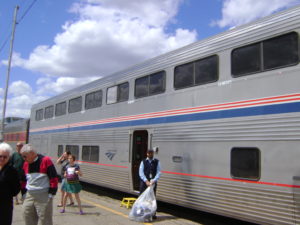
Learn train vocabulary as we become more familiar with our content theme. Grab a notebook, and start writing responses to our language activities.
Here’s the link to Episode 2 as seen on RVTV: Episode 2
Here’s an alternate link to Episode 2.
Click here for Segment 1
To see Segment 2, click here
Click here for Segment 3
Welcome to the support page for Episode 2 of Ramping Up your English! Episode 2 was produced at the Digital Media Center on the campus of Southern Oregon University in Ashland, Oregon on April 4, 2015. While Episode 1 served as a general introduction, Episode 2 saw us dig into some more direct instruction.
Segments
With a quick reminder that Ramping Up your English is designed for intermediate level English Learners, let’s look at the 3 segments:
Segment One: First, we quickly reviewed Segment One vocabulary, then we supported our theme with a video clip entitled RUE Freight Trains 1. Click here for the video on archive.org. The assignment was simply to watch the video and see how much you understand. After that, we used the video clip to describe a freight train by listing its parts, while using intermediate sentence construction (…a freight train has a locomotive, a…”) Finally, we modeled how to take this simple function and ramp it up by using “is made up of” and “consists of” to break free of the overuse of “has.”
A Freight train is made up of four locomotives, many lumber cars, some box cars, tank cars, flat cars, hopper cars and a gondola.
A freight train consists of four locomotives, many lumber cars, some box cars, tank cars, flat cars, hopper cars, and a gondola.
Homework Assignment: Describe object by listing their parts. Examples… your bedroom, a car, your outfit, your classroom. Use the phases “is made up of” and “consists of” like the example we did describing freight trains.
Segment two: After watching the video clip RUE Freight Trains 2, we found meanings for the list of words that made up our homework from Episode 1. Click here to see the clip on archive.org. In addition, we addressed the language function of describing the function of something, in this case a freight yard. First of all, we suggested some sentences that would be typical of intermediate level English learners, after which we modeled using a higher language register to communicate the same thing. There was no assignment made, as this was supporting patterning.
Video Clips: Click below to view the video clips used in this episode:
View Freight Trains 2
Watch Freight Trains 3
POSSIBLE ANSWERS TO EPISODE 1 HOMEWORK:
Commuter trains = Don’t know
coal train = coal is carbon? (looks like it)
freight containers – what I saw (picture)
Conductors – man with “funny” hat?
INTERMEDIATE LEVEL SENTENCES.
The freight yard is where freight trains are serviced.
A freight yard is where freight cars are switched to reach their destination.
The freight yard is where cargo containers are moved from ships to rail cars.
RAMPED UP SENTENCES
The freight yard performs multiple functions important to railroads.
Trains are serviced there, and cars are switched to facilitate movement to their destinations.
Additionally, this particular yard contains equipment for lifting cargo containers from ships and placing them on rail cars.
Segment 3: Click here to see RUE Freight Trains 3 on archive.org. After so much direct instruction in the previous segments, we watched RUE Freight Trains 3 with the assignment to note how much of the narration you can understand, using the context clues in the video clip. I especially enjoy this clip because it contains an engineer in a mock-up of a cab showing how he would use the controls to bring a train through the mountains of Oregon.
If you’re just joining us at Ramping Up your English, I suggest you watch Episode 1 before going on the episode 2. Remember to get a notebook if you plan to do these lessons and the ones that follow.
Language Objectives: Identify meanings of unit vocabulary. Describe the function of a place (Freight Yard). Assessment: Informally assess your comprehension of materials presented in the form of a video clip.
Academic Content Objectives: Transportation/Railroads. Transportation of freight. Understand the meanings of Unit vocabulary. Explain the functions of components of the Railraod as a system.
Click here to view the Episode 3 page.